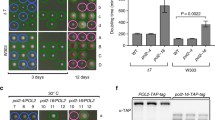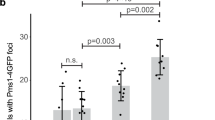Abstract
A Neurospora crassa gene encoding a product with homology to the Saccharomyces cerevisiae Rad1 nucleotide excision repair (NER) protein was isolated by degenerate PCR. The predicted protein consists of 892 amino acids with a molecular weight of 100.4 kDa, and 32–37% identity to the XPF/ERCC4 protein family. The homolog was mapped to the left arm of linkage group I, the location of the mus-38 gene. Subsequently, gene inactivation and complementation studies identified the RAD1 homolog as mus-38. Immunological assays showed that the mus-18 (UV-specific endonuclease) and mus-38 strains have partial and normal UV-damage excision activities, respectively, but removal of thymine dimers and TC (6-4) photoproducts is abolished in the mus-18 mus-38 double mutant. The double mutant also was synergistically more sensitive to UV than either single mutant. The data suggest that mus-38 may participate in a different NER pathway from that involving the mus-18 gene.
Similar content being viewed by others
Author information
Authors and Affiliations
Additional information
Received: 27 November 1997 / 28 January 1998
Rights and permissions
About this article
Cite this article
Hatakeyama, S., Ito, Y., Shimane, A. et al. Cloning and characterization of the yeast RAD1 homolog gene (mus-38) from Neurospora crassa: evidence for involvement in nucleotide excision repair. Curr Genet 33, 276–283 (1998). https://doi.org/10.1007/s002940050337
Issue Date:
DOI: https://doi.org/10.1007/s002940050337




